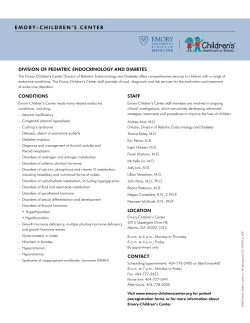
The Endocrine System Chapter 47 1
The Endocrine System Chapter 47 1 Outline • • • • • • • • • Types of Regulatory Molecules Endocrine Glands and Hormones Paracrine Regulation Hormones That Enter Cells Hormones That Do Not Enter Cells Posterior and Anterior Pituitary Gland Thyroid and Parathyroid Glands Adrenal Glands Other Endocrine Glands 2 Types of Regulatory Molecules • • • • Hormone – A regulatory chemical secreted into the blood by an endocrine gland, or an organ exhibiting endocrine function. Target Cells respond to hormone – Neurohormone – A chemical messenger secreted by neuron into the blood rather than the synaptic cleft. Paracrine - regulatory molecules work without being transmitted by the blood – not endocrine Pheromone - communication messengers 3 Copyright © The McGraw-Hill Companies, Inc. Permission required for reproduction or display. Endocrine gland Axon Neurotransmitter Hormone carried by blood Receptor proteins Paracrine regulator Target cell 4 Endocrine Glands and Hormones • Hormones secreted by the endocrine glands belong to four chemical categories: – Polypeptides - short chains of amino acids less than 100 amino acids (insulin & ADH) – Glycoproteins- longer than100 A.A. with carbs (FSH and LH) – Amines - Amines – A.A. derived from tyrosine and tryptophan – epinephrine and norepinephrine and melatonin – Steroids - lipids derived from cholesterol sex steroids - testosterone, estadiol, progesterone, and cortisol – secreted by testes, ovaries, placenta and adrenal cortex Corticosteroids - adrenal cortex cortisol and aldosterone (regulates glucose and salt balance) – All hormones can be categorized as lipophilic (fat 5 soluble) or hydrophilic (water soluble). Endocrine Glands and Hormones • Neural and endocrine interactions – Endocrine system also interacts and cooperates with the nervous system to regulate the activities of the other organ systems of the body. – Secretory activity of many endocrine glands controlled by nervous system like Adrenal medulla, posterior pituitary, and pineal gland major site for neural regulation is the brain’s regulation of the anterior pituitary by the hypothalmus However many are not under neural control 6 Human Endocrine System major glands 7 Paracrine Regulation • • Signaling between cells - Local effect and short-lived occurs in many organs Regulatory molecules – cytokines - regulate different cells of the immune system – growth factors - promote growth and cell division in specific organs – stimulate cell division at target cells 8 Paracrine Regulation • • • Prostaglandins – most diverse group of paracrine regulators participate in regulation of: – immune system – inflammation, pain and fever – reproductive system – reproductive function ovulation, labor, – digestive system – inhibit gastric secretions, incrfease motility and fluid absorption – respiratory system - blood vessels constriction and dilation in lungs – circulatory system - blood platelets in blood clotting – urinary system - renal blood flow vasodilation increasing urine excretion Prostaglandin synthesis inhibited by aspirin. – nonsteroidal anti-inflammatory drug Ibuprofen Work to inhibit inflammation and pain by inhibiting enzyme necessary to produce prostaglandins – 9 (cyclooxygenase -2) Hormones That Enter Cells • Lipophilic hormones pass through the target cell’s plasma membrane and bind to intracellular receptor proteins. – hormone receptor complex then binds to specific regions of DNA activate genes and regulate target cells 10 Steroid Hormone Action 11 Hormones That Do Not Enter Cells • Hormones that are too large or too polar to cross plasma membranes include all of the peptide and glycoprotein hormones, as well as catecholamine hormones epinephrine and norepinephrine. – bind to receptor proteins located on the outer surface of the plasma membrane cyclic AMP second-messenger system ++ second-messenger system IP3/CA 12 Action of Epinephrine on a Liver Cell 1. Epinephrine is lipophobic and needs to bind to specific receptor proteins on cell surface. 2. Acting through intermediary G proteins the hormone bound receptor activates the enzyme adenenylyl cyclase which converts ATP to cAMP 3. Cyclic AMP performs as a 2ndary messenger and activates protein kinase-A an enzyme that was previously inactive 4. Protein kinase–A phosphorylates and activates the enzyme phosphorylase which catalyses the hydrolysis of glycogen into glucose. 13 IP3/CA++ Second-Messenger System 1. The hormone epinephrine binds to specific receptor proteins on the cell surface. 2. Acting through G- proteins, the hormone-bound receptor activates the enzyme phospholipase C, which converts membrane phospholipids into inositol triphosphate (IP3) 3. IP3 diffuses thru the cytoplasm and binds to receptors on the endoplasmic reticulum 4. The binding of IP3 to the receptor stimulates the endoplasmic reticulum to release Ca++ into the cytoplasm 5. Some of the released Ca++ binds to the receptor protein called calmodulin 6. The Ca++/Calmodulin complex activates other intracellular proteins – producing the horomone effects 14 Posterior Pituitary Gland • • Pituitary gland hangs by a stalk from the hypothalamus of the brain. – anterior pituitary - appears glandular – posterior pituitary - appears fibrous Neurons produce antidiuretic hormone (ADH) and oxytocin. – stored in, and released from, the posterior pituitary gland in response to neural stimulation from the hypothalamus 15 Effects of ADH 16 Anterior Pituitary Gland • Develops from a pouch of epithelial tissue that pinches off the roof of the embryo’s mouth. – produces the hormones it secretes: growth hormone (GH) stimulates muscles and bones to grow adrenocorticotropic hormone (ACTH) regulates glucose homeostasis thyroid-stimulating hormone (TSH) stimulates the production of thyroxin by thyroid gland luteinizing hormone (LH) ovulation and testosterone production in testes follicle-stimulating hormone (FSH) develops ovarian follicle and sperm in males prolactin (PRL) stimulates mammary glands to produce milk melanocyte-stimulating hormone (MSH) synthesis and dispersion of melanin pigment 17 Major Pituitary Gland Hormones 18 Anterior Pituitary Gland • Hypothalamic control of anterior pituitary gland secretion – Neurons in the hypothalamus secrete releasing hormones and inhibiting hormones into blood capillaries at the base of the hypothalamus. Each hormone delivered by hypothalamohypophysial portal system regulates secretion or inhibition of a specific anterior pituitary hormone. 19 Neurons in the hypothalamus secretes hormones that are carried by short blood vessels directly to the ant. Pituitary gland, where they either stimulate or inhibit the secretions of the ant pituitary hormones Cell body Axons to primary capillaries Portal venules Primary capillaries Pituitary stalk Secondary capillaries Posterior pituitary Anterior pituitary 20 Anterior Pituitary Gland • Negative feedback inhibition acts to maintain relatively constant levels of the target cell hormone. – Positive feedback cannot maintain constancy of the internal environment. 21 Negative Feedback Inhibition Hormones secreted by some endocrine glands feed back to inhibit the secretion of hypothalamic releasing hormones and anterior pituitary hormones 22 Thyroid and Parathyroid Glands • Thyroid gland – Shaped like a shield and lies just below the Adam’s apple in the front of the neck. Thyroxine helps set basal metabolic rate by stimulating the rate of cell respiration. In children, thyroid hormones also promote growth and stimulate maturation of the central nervous system. unique function in amphibians metamorphosis from larvae into adults 23 Regulation of Thyroxine Secretion 24 Thyroid and Parathyroid Glands • Parathyroid gland and calcium homeostasis – four small glands attached to the thyroid produces parathyroid hormone (PTH) one of only two hormones in humans that are absolutely essential for survival stimulates osteoclasts in bone to dissolve calcium phosphate crystals and release Ca++ into the blood 25 Regulation of Blood Calcium Levels 26 Adrenal Glands • • Adrenal glands are located above each kidney. – Each gland composed of inner portion (adrenal medulla) and outer layer (adrenal cortex). Adrenal medulla – receives neural input from axons of sympathetic division of the autonomic nervous system, and secretes epinephrine and norepinephrine in response 27 Adrenal Glands • Adrenal cortex – Hormones from adrenal cortex are collectively referred to as corticosteroids. Cortisol maintains glucose homeostasis, and modulates some aspects of the immune response. Aldosterone stimulates the kidneys to reabsorb Na+ and secrete K+ into the urine. 28 Adrenal Glands 29 Pancreas • Located adjacent to the stomach and is connected to the duodenum by the pancreatic duct. – Secretes bicarbonate ions and a variety of digestive enzymes into small intestine. cells of islets of Langerhans secrete insulin, and cells secrete glucagon. antagonistic Insulin lowers while glucogen raises blood glucose. 30 Antagonistic Actions of Insulin and Glucagon 31 Other Endocrine Glands • • Ovaries and testes – produce androgen secondary sexual characteristics Pineal gland – secretes melatonin regulates biological clocks 32 Other Endocrine Glands • Molting and metamorphosis in insects – Hormone secretions influence both molting and metamorphosis in insects. Brain hormone stimulates production of ecdysone (molting hormone). high levels cause molting to occur juvenile hormone high levels prevent transformation to an adult 33 Other Endocrine Glands • Endocrine disrupting chemicals – chemicals that interfere with hormone function Any chemical that can bind to receptor proteins and mimic the effects of the hormone is called a hormone agonist. Any chemical that binds to receptor proteins and has no effect, but blocks the hormone from binding is a hormone antagonist. 34 Summary • • • • • • • • • Types of Regulatory Molecules Endocrine Glands and Hormones Paracrine Regulation Hormones That Enter Cells Hormones That Do Not Enter Cells Posterior and Anterior Pituitary Gland Thyroid and Parathyroid Glands Adrenal Glands Other Endocrine Glands 35 36
© Copyright 2025





















